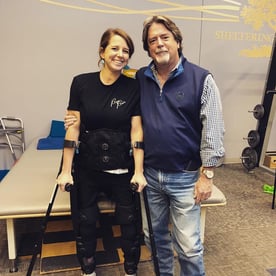Using Meditation for Rehabilitation
Before my accident in 2005, I was a pretty normal teenager. I was about to start my sophomore year in high school, I was active on 3 competitive sports teams, and I had a close friendship with Little Debbie and her Zebra cakes. I was “in touch” with my body as far as eating junk food then exercising are concerned but, mentally, much to be desired. Seeing as I was a healthy and able-bodied teenager, that’s probably not a totally unique sentiment.
When I was hit by a jet ski at the end of the summer before my sophomore year and condemned to a wheelchair, I promised myself that I’m going to make the most of it; in regard to both my lifestyle and my rehabilitation. I was determined to continue living positively and healthily. To take it one step further and despite the lack of hope my doctors gave me, I adopted the goal of regaining as much sensory and motor function as I could.

That meant forcing a love for working out, participating in adaptive sports, and tuning in to my body. More specifically, I had to tune in to the connection between my body and my mind.
Enter: meditation.
Meditation is not something I ever really considered before I was in an accident, but it has been a major part of my life ever since. I meditate to actively train my mind to remember how to feel sensations or movement below my level of injury. My personal meditation is mostly based on my hope and certitude that my paralyzed limbs will one day move for me. The more brain signals I send down the pathways to my lower body, the more likely one will break through the fog that my disability raises.
There are more tangible and more universal benefits to meditation beyond my personal sensory rehabilitation – don’t worry. For starters, tuning in to your body loosens the connections to particular brain pathways, therefore reducing the instance of anxiety and depression. Especially now, we can all use a little of that power.
Meditating and mindfulness reduce cortisol levels, which is the stress hormone. It also increases creativity, enhances self-awareness, and preserves your brain as you age. With everything going on in the world and through our minds, I do realize that it’s not easy to set aside time to fully focus on yourself. But I’m telling you that it’s worth it. Meditating will get easier each time you do it, too; by increasing grey matter in the frontal cortex of your brain, your ability to focus will be sharpened.
I’m not saying that I have the desire or the discipline to transfer to the ground, cross my legs, and meditate as a part of my daily routine. If I had about 5 more hours in my day, I would prioritize that kind of thing. Meditation comes to me while I’m lying in bed at night when I’m forced to be in my thoughts. It can get a bit boring, so I also use it as an aide to my falling asleep. Until I do drift off, though, I lay there and focus on the feelings and sounds of my body. Like, really focus.
I have decreased feeling below my mid-torso so, for me, meditation looks like focusing my thoughts toward my feet and trying to wiggle my toes. Whether or not they move (usually they don’t), my focusing on and sending brain signals down through my paralyzed body means the fog clouding my pathways is cleared a tiny, tiny bit more.
The reward at the end of my personal “Meditation Tunnel” has been movement in those areas. I have spent so much time focusing on my feet, toes, and butt. In the beginning of my disability, I sat for hours at a time, staring at my toes, and trying to get them into wiggling. That practice, combined with the health of my body through physical exercise, a healthy diet, and a truckload of patience, enabled me to regain some movement in my lower half and move my disability from a Complete to Incomplete classification.
Honestly, I wish someone told me sooner about the power of my mind to erase parts of my disability. It took me a couple years to realize the potential, which led me to the realization that there truly is no such thing as “no hope.” In every way, this was life changing.
Whether you utilize meditation for stress relief and self-awareness or, like me, to pull your body away from disability, it can be a crucial part of endurance for your aging mind. Meditation has also been shown to increase dopamine and serotonin levels in our brains, which are associated with happiness and positivity. Again, something we can all use some of.
Clearly, meditation is a good practice for everyone to adopt in our day to day routines. Whether it’s for 5 minutes or 30 minutes, it’ll enhance our response to the world around us, as well as the performance of our minds in the long term. If you’re like me and you forget to meditate, or can’t make time during the day, try meditating yourself to sleep at night. If you’re not sure how, I use this online resource on Mindful.org and the app Headspace. Also you can watch this video on Mindfulness Mediation on the Reeve website. You got this.
Just breathe.
Hold for 20 seconds.
And breathe out.
Kristin Beale is a native of Richmond, Virginia. She is the author of two books, Greater Things and A Million Suns, and a comic book, Date Me. Check them out and read an excerpt at https://kristinbeale.com/. Her comics can be found on Instagram @Greater.Things.Comics.
Join Our Movement
What started as an idea has become a national movement. With your support, we can influence policy and inspire lasting change.
Become an Advocate